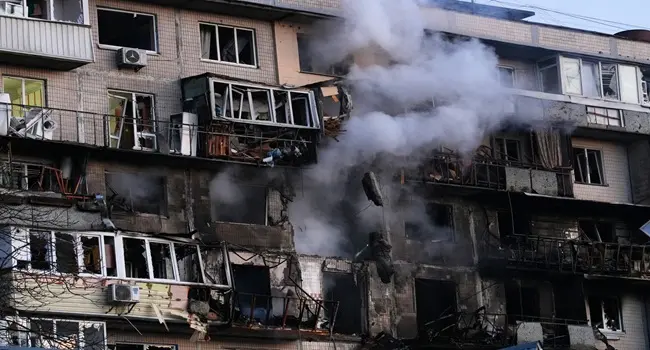Almost every district in Kyiv came under a “massive” attack on Friday morning, the city’s mayor said, as Russian missiles and drones struck residential areas and critical infrastructure, leaving one person dead and damaging at least 30 apartment buildings.
Russia, which launched its full-scale invasion of Ukraine in 2022, has intensified strikes in recent months, increasingly targeting energy facilities, rail lines, and civilian neighbourhoods.
Mykola Kalashnyk, head of the Kyiv regional military administration, said the latest barrage was aimed at critical infrastructure in and around the capital. Mayor Vitaly Klitschko described it as a “massive enemy attack,” adding that air defence systems were actively responding.
According to Kyiv police, an elderly woman was killed and at least 24 people including a pregnant woman and a 10-year-old boy were wounded. Fires and widespread destruction prompted Ukrainian emergency services to rescue more than 40 people across the city.
Klitschko said sections of the heating network were damaged, temporarily leaving parts of the northeastern Desnyansky district without heat. Electricity and water supplies could also face disruptions, he warned. City authorities reported partial blockage of transport routes, with delays to buses and trams.
AFP journalists in the capital witnessed the use of tracer ammunition against drones and the deployment of several anti-missile systems. “Russians are hitting residential buildings. There are a lot of damaged high-rise buildings throughout Kyiv, almost in every district,” said Tymur Tkachenko, head of the city’s military administration.
Entrenched war
The attack comes as Kyiv’s Western allies escalate pressure on Russia. On Wednesday, Canada announced new sanctions targeting Russia’s drone and energy production sectors, as well as infrastructure used for cyberattacks. That same day, G7 foreign ministers called for an immediate ceasefire and reiterated their “unwavering” support for Ukraine’s territorial integrity.
Meanwhile, the European Commission is considering redirecting part of Russia’s frozen assets to provide Ukraine with a multiyear loan for budgetary and military support.
But nearly four years into the war, both sides remain deeply entrenched. Moscow has dismissed ceasefire appeals and shown little interest in efforts by US President Donald Trump to revive long-stalled peace negotiations.
Russian forces have been pushing forward in eastern Ukraine for months in a bid to seize more territory in the Donetsk and Lugansk regions. On Monday, Moscow claimed to have captured three additional villages along the sprawling front line, where it continues to leverage its advantage in manpower and equipment.
Analysts warn that Russia’s renewed focus on Ukraine’s energy grid risks severe heating shortages as winter approaches.
Ukraine, for its part, has stepped up strikes on Russian infrastructure, including deep-inside-Russia attacks.
Russia’s defence ministry said its forces shot down more than 200 Ukrainian drones overnight into Friday, including 66 over Krasnodar Krai and 45 over Saratov.
Authorities in Krasnodar Krai said a fire broke out at the Sheskharis oil refinery—one of Russia’s largest, in the Black Sea port of Novorossiysk, before it was contained. A civilian vessel in the port was also damaged, with three crew members wounded and hospitalised, they added.
AFP


